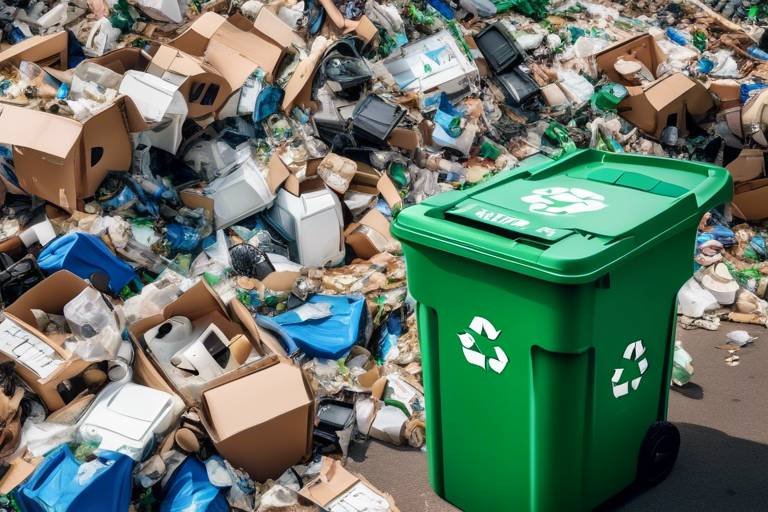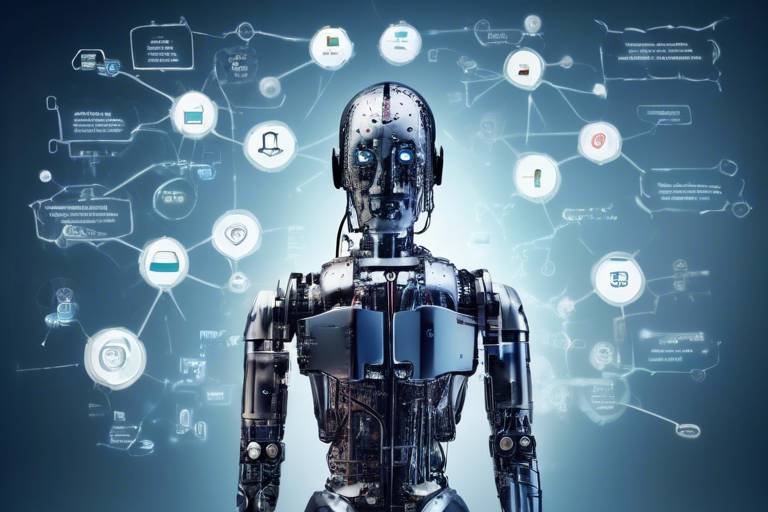The Role of AI in Recycling and Waste Management
In a world where waste management and recycling are becoming increasingly critical, artificial intelligence (AI) is stepping up as a game-changer. Imagine a scenario where trash is sorted with the precision of a surgeon—no more contamination, no more recyclable materials ending up in landfills. This is the promise of AI in the recycling industry. It’s not just about cleaning up our planet; it's about creating a system that works smarter, not harder. AI is transforming the way we handle waste, making processes more efficient and sustainable. So, how exactly is AI reshaping recycling and waste management? Let's dive into the details!
AI technology encompasses a range of innovative tools and approaches, including machine learning, data analytics, and automation. These technologies work together to enhance decision-making processes in recycling and waste management. Think of AI as the brain behind the operation, optimizing everything from sorting materials to managing collection schedules. By analyzing vast amounts of data, AI helps organizations identify patterns and make informed decisions that lead to better resource allocation and operational efficiency. This means less waste and more materials being recycled—an absolute win-win for our environment.
One of the most significant advantages of AI in recycling is its ability to improve sorting accuracy. Traditional recycling methods often struggle with contamination, where non-recyclable materials mix with recyclables, leading to increased costs and wasted resources. However, with AI, we can achieve:
- Increased Sorting Accuracy: AI systems can identify materials with remarkable precision, ensuring that only suitable items are sent for recycling.
- Reduced Contamination: By accurately sorting materials, AI minimizes the risk of contamination, which is crucial for maintaining the quality of recycled products.
- Maximized Material Recovery: With better sorting and processing, more materials can be recovered, leading to a more efficient recycling system.
These benefits culminate in a more streamlined recycling process that not only saves money but also significantly reduces waste in our landfills.
Automated sorting systems powered by AI algorithms are revolutionizing the way we handle waste. These systems can quickly and accurately identify and separate recyclable materials from general waste. Imagine a conveyor belt where AI eyes are constantly scanning materials, swiftly categorizing plastics, metals, and paper while discarding non-recyclables. This ensures higher purity levels of recyclables, which is essential for effective recycling. The result? A higher quality of materials that can be reintroduced into the manufacturing cycle, reducing the need for virgin resources.
Machine learning, a subset of AI, plays a vital role in analyzing vast datasets to predict waste generation patterns. By understanding these patterns, organizations can optimize their collection routes and schedules. For instance, if a neighborhood consistently generates more waste on weekends, companies can adjust their collection schedules accordingly to improve efficiency. This not only saves time and fuel but also enhances resource management, making waste collection smarter and more responsive to community needs.
Predictive analytics tools are essential in leveraging historical data to forecast recycling trends. By analyzing past recycling rates and patterns, municipalities can allocate resources more effectively, ensuring that they meet the demands of their communities. This proactive approach leads to improved recycling rates and better management of resources, ultimately benefiting the environment.
Real-time monitoring systems equipped with AI can track waste levels and composition, enabling timely interventions. Imagine a smart bin that alerts waste management services when it’s nearing capacity. This reduces the chances of overflow or underutilization of containers, ensuring that waste is collected efficiently and effectively. Such systems not only improve operational efficiency but also contribute to a cleaner and more sustainable environment.
Despite the numerous benefits, implementing AI in recycling and waste management is not without its challenges. Some of the hurdles include:
- High Initial Costs: The setup and integration of AI systems can be expensive, which may deter some organizations from making the leap.
- Data Privacy Concerns: With increased data collection comes the responsibility of protecting that data, raising concerns about privacy and security.
- Need for Skilled Personnel: Operating and managing AI systems requires a skilled workforce, which may not always be readily available.
Addressing these challenges is crucial for maximizing the potential of AI in the recycling sector.
The future of AI in waste management looks promising, with advancements in robotics, enhanced data integration, and increased collaboration between public and private sectors. As technology continues to evolve, we can expect:
- Integration with IoT: The combination of AI with Internet of Things (IoT) devices will revolutionize waste tracking and management, providing real-time data for improved decision-making.
- Collaborative Efforts for Sustainability: Partnerships among governments, businesses, and technology providers will be essential in leveraging AI for sustainable waste management practices.
These trends not only aim to improve the efficiency of waste management but also strive to achieve the goals of a circular economy, where waste is minimized, and resources are reused and recycled to their fullest potential.
1. How does AI improve recycling rates?
AI enhances recycling rates by improving sorting accuracy, reducing contamination, and maximizing material recovery, which leads to a more efficient recycling system.
2. What are the challenges of implementing AI in waste management?
Challenges include high initial costs, data privacy concerns, and the need for skilled personnel to operate AI systems.
3. How does machine learning contribute to waste management?
Machine learning analyzes data to predict waste generation patterns, helping optimize collection routes and schedules.
4. What role do IoT devices play in waste management?
IoT devices, when integrated with AI, provide real-time data for tracking waste levels and improving overall operational efficiency.

Understanding AI Technology
Artificial Intelligence (AI) technology is revolutionizing various industries, and recycling and waste management are no exceptions. At its core, AI encompasses a blend of machine learning, data analytics, and automation. These components work together to enhance decision-making processes, optimize operations, and improve resource allocation. Imagine a world where waste is sorted and processed with the precision of a skilled artisan, all thanks to intelligent algorithms and advanced data processing.
Machine learning, a subset of AI, allows systems to learn from data patterns and improve over time without being explicitly programmed. This means that the more data AI systems process, the better they become at identifying recyclable materials and predicting waste generation trends. For instance, by analyzing historical data, AI can forecast when and where waste will accumulate, which is invaluable for planning efficient collection routes. This not only saves time but also reduces operational costs, making waste management more sustainable.
Data analytics plays a crucial role in AI as well. It involves examining raw data to draw meaningful insights, which can significantly enhance the efficiency of recycling processes. With data analytics, organizations can track the types and volumes of waste generated, leading to better resource allocation. For example, if a particular area produces more plastic waste, targeted initiatives can be developed to improve recycling rates in that region.
Automation is another vital aspect of AI technology in waste management. Automated systems can handle repetitive tasks, such as sorting materials, allowing human workers to focus on more complex issues. This not only increases productivity but also reduces the risk of human error, ensuring that recyclable materials are correctly identified and processed. The combination of these technologies leads to a more streamlined and effective recycling operation.
To sum it up, the integration of AI technology in recycling and waste management is not just a trend; it's a necessary evolution. With the ability to analyze vast amounts of data, learn from patterns, and automate processes, AI is paving the way for a smarter, more efficient, and sustainable approach to managing waste. The future looks bright, and as we continue to harness the power of AI, we can expect remarkable improvements in how we deal with waste.

Benefits of AI in Recycling
Artificial Intelligence (AI) is not just a buzzword; it’s a game-changer in the world of recycling. Imagine a world where waste is sorted with the precision of a skilled artisan, where contamination rates drop like a rock, and where every recyclable material finds its way back into the production cycle. That’s the promise of AI in recycling! By harnessing advanced technologies, AI enhances the entire recycling process, making it not only more efficient but also more sustainable.
One of the most significant benefits of AI in recycling is its ability to increase sorting accuracy. Traditional recycling methods often rely on manual sorting, which can be time-consuming and prone to human error. With AI-powered sorting systems, materials can be identified and separated with remarkable precision. These systems utilize sophisticated algorithms to analyze the composition of waste, ensuring that recyclables are not just tossed into a bin haphazardly. Instead, they are sorted into distinct categories, ready for processing. This means less contamination and higher-quality recyclables.
Moreover, AI helps in reducing contamination rates. When recyclable materials are mixed with non-recyclables, it can lead to entire batches being deemed unusable. AI systems can detect these contaminants and remove them before they reach the recycling facility, thereby preserving the integrity of recyclable materials. This not only enhances the quality of the recyclables but also saves resources that would otherwise be wasted in processing contaminated materials.
Another key advantage is the ability of AI to maximize material recovery. By analyzing data from various sources, AI can identify which materials are most commonly discarded and develop strategies to recover them effectively. For instance, if a particular type of plastic is frequently found in the waste stream, AI can optimize the recycling process to ensure that it is collected and processed efficiently. This leads to a more circular economy, where materials are reused rather than sent to landfills.
To illustrate the impact of AI on recycling, consider the following table that outlines key benefits:
| Benefit | Description |
|---|---|
| Increased Sorting Accuracy | AI systems can identify and separate materials with high precision, reducing human error. |
| Reduced Contamination | AI detects and removes contaminants, preserving the quality of recyclables. |
| Maximized Material Recovery | AI analyzes waste data to optimize recovery strategies for various materials. |
In addition to these benefits, AI also plays a crucial role in streamlining operations. By automating sorting processes, companies can reduce labor costs and increase throughput. This means that more materials can be processed in a shorter amount of time, leading to a more efficient recycling operation overall. The result? A significant boost in productivity and a positive impact on the environment.
Furthermore, AI’s ability to provide real-time analytics allows organizations to adapt their recycling strategies on the fly. By monitoring waste composition and recycling rates, companies can make informed decisions that enhance their operations. This agility is vital in a world where sustainability goals are constantly evolving.
In summary, the benefits of AI in recycling are profound and far-reaching. From increasing sorting accuracy and reducing contamination to maximizing material recovery and streamlining operations, AI is paving the way for a more sustainable future. As we continue to innovate and integrate AI technologies, the recycling landscape will transform, making it more efficient and effective than ever before.
- How does AI improve recycling accuracy? AI uses advanced algorithms to analyze waste materials, allowing for precise sorting and separation.
- What are the environmental benefits of AI in recycling? By reducing contamination and maximizing recovery, AI helps divert more materials from landfills, promoting sustainability.
- Can AI help in predicting recycling trends? Yes, AI can analyze historical data to forecast waste generation patterns, enabling better resource management.

AI-Powered Waste Sorting Systems
In today's fast-paced world, where waste generation is skyrocketing, are emerging as a beacon of hope. These systems are not just fancy gadgets; they represent a significant leap forward in how we handle waste. Imagine a world where machines can sort through mountains of trash with the precision of a skilled artisan. That's the promise of AI in waste management. By employing sophisticated algorithms, these systems can identify and separate recyclable materials from general waste, ensuring that what can be reused doesn't end up in a landfill.
One of the most remarkable aspects of AI-powered sorting systems is their ability to achieve higher purity levels in recyclables. Traditional sorting methods often lead to contamination, which can render entire batches of recyclables useless. However, with AI, the sorting process becomes more efficient and accurate. For instance, AI systems can use computer vision to recognize different materials—like plastics, metals, and paper—at astonishing speeds. This technology can analyze images in real-time, making split-second decisions about what goes where.
To illustrate the impact of these systems, consider the following table that highlights key features and benefits of AI-powered waste sorting systems:
| Feature | Benefit |
|---|---|
| Real-time Material Recognition | Increased sorting speed and accuracy |
| Automated Sorting | Reduced labor costs and human error |
| Data Analytics | Improved decision-making for waste management |
| Scalability | Easily adaptable to different waste volumes |
Moreover, the integration of AI in waste sorting systems allows for continuous learning. As these systems process more waste, they gather data that helps them become increasingly efficient over time. This self-improvement aspect is akin to how we learn from our experiences—making mistakes and adjusting accordingly. The more data these systems collect, the better they get at identifying materials, which ultimately leads to maximizing material recovery.
However, it’s not just about technology; it’s also about the impact on our environment. By improving the quality of recyclable materials, AI-powered sorting systems contribute to a more sustainable future. They pave the way for a circular economy where resources are reused and recycled rather than discarded. This is crucial in combating the growing issue of waste pollution, which poses a significant threat to our planet.
In conclusion, AI-powered waste sorting systems are revolutionizing the recycling landscape. They not only enhance operational efficiency but also promote a sustainable approach to waste management. As we continue to innovate and integrate these technologies, the future looks promising for both our environment and our communities.
Frequently Asked Questions
- What are AI-powered waste sorting systems?
They are advanced systems that use artificial intelligence to identify and separate recyclable materials from waste, improving sorting accuracy and efficiency. - How do these systems improve recycling rates?
By reducing contamination and maximizing the recovery of recyclable materials, AI systems ensure that more materials are processed correctly. - Can AI systems learn over time?
Yes, AI-powered sorting systems utilize machine learning to continuously improve their sorting capabilities based on the data they collect. - What impact do these systems have on the environment?
They contribute to a circular economy by increasing the quality and quantity of recyclables, thereby reducing waste pollution.

Machine Learning in Waste Management
Machine learning is revolutionizing waste management by providing innovative solutions that were previously unimaginable. Imagine a world where garbage trucks know exactly when to pick up waste, reducing fuel consumption and operational costs significantly. This is not just a dream; it’s becoming a reality thanks to advanced algorithms that analyze vast amounts of data. These algorithms can predict waste generation patterns based on various factors such as time of year, local events, and even weather conditions. By leveraging this data, waste management companies can optimize their collection routes and schedules, ensuring that resources are used more efficiently.
One of the most exciting aspects of machine learning in waste management is its ability to continuously improve over time. As more data is collected, the algorithms become smarter, refining their predictions and enhancing operational efficiency. For instance, if a particular neighborhood consistently generates more waste during the summer months due to community events, the system can adjust collection schedules accordingly. This adaptability not only saves time and money but also minimizes the environmental impact by reducing unnecessary trips.
Moreover, machine learning can help identify trends in recycling behaviors. By analyzing data from various sources, such as social media and community feedback, waste management organizations can tailor their educational campaigns to promote better recycling practices. For example, if data shows that a specific demographic is less likely to recycle certain materials, targeted outreach can be developed to address these gaps. This proactive approach fosters a culture of sustainability and encourages community involvement.
To illustrate the effectiveness of machine learning in waste management, consider the following table that showcases the impact of predictive analytics on operational efficiency:
| Metric | Before Machine Learning | After Machine Learning Implementation |
|---|---|---|
| Fuel Consumption | 500 gallons/week | 350 gallons/week |
| Collection Time | 30 hours/week | 20 hours/week |
| Missed Pickups | 15 | 3 |
As shown in the table, the implementation of machine learning has led to significant improvements in key performance metrics. The reduction in fuel consumption and collection time not only benefits the waste management companies financially but also contributes to environmental sustainability by lowering carbon emissions.
In conclusion, machine learning is not just a technological advancement; it is a crucial component in the quest for more efficient and sustainable waste management practices. By harnessing the power of data, organizations can make informed decisions that enhance their operations, promote recycling, and ultimately contribute to a cleaner planet.
- What is machine learning? Machine learning is a subset of artificial intelligence that enables systems to learn from data and improve their performance over time without explicit programming.
- How does machine learning help in waste management? It helps by analyzing data to predict waste generation, optimizing collection routes, and identifying recycling trends to improve efficiency and sustainability.
- Are there any challenges in implementing machine learning in waste management? Yes, challenges include high initial costs, the need for skilled personnel, and concerns about data privacy.
- What is the future of machine learning in waste management? The future includes enhanced data integration, real-time monitoring, and increased collaboration between various sectors to drive sustainability efforts.

Predictive Analytics for Recycling
Predictive analytics is revolutionizing the way we approach recycling by utilizing historical data to forecast future trends. Imagine having a crystal ball that not only shows you how much recyclable material will be generated in your community but also helps you anticipate the best times to collect it. This is precisely what predictive analytics does—it empowers municipalities and organizations to allocate their resources more effectively. By analyzing past recycling patterns, these tools can identify peak times for waste generation, allowing for more efficient collection schedules.
For instance, cities can use predictive models to determine when certain neighborhoods are likely to produce more recyclables, enabling them to adjust their collection routes accordingly. This not only saves time and fuel but also reduces the carbon footprint associated with waste collection. Moreover, by optimizing collection schedules based on data-driven insights, municipalities can significantly enhance their recycling rates.
The power of predictive analytics lies in its ability to process vast amounts of data, transforming it into actionable insights. As a result, organizations can make informed decisions that lead to improved recycling outcomes. For example, if a predictive model indicates that a particular area is likely to produce an uptick in plastic waste during summer months, the local waste management authority can prepare by increasing collection frequency or launching targeted awareness campaigns about recycling practices.
To illustrate the impact of predictive analytics, consider the following table that shows a hypothetical city's recycling rates before and after implementing predictive analytics tools:
| Year | Recycling Rate (%) | Collection Efficiency (tons/hour) |
|---|---|---|
| 2019 | 25 | 2.5 |
| 2020 | 30 | 3.0 |
| 2021 | 35 | 4.0 |
| 2022 | 45 | 5.5 |
As shown in the table, the implementation of predictive analytics led to a significant increase in both recycling rates and collection efficiency over the years. This data not only highlights the benefits of using advanced analytics but also showcases the potential for continuous improvement in recycling programs.
In conclusion, predictive analytics is not just a buzzword; it's a critical tool that can help reshape our recycling efforts. By leveraging data to anticipate trends and optimize operations, communities can enhance their recycling systems, reduce waste, and promote sustainability. The future of recycling is bright, and predictive analytics is at the forefront of this transformation.
- What is predictive analytics in recycling?
Predictive analytics in recycling refers to the use of historical data and statistical algorithms to forecast future recycling trends, helping organizations optimize their operations. - How can predictive analytics improve recycling rates?
By analyzing past data, predictive analytics allows municipalities to identify peak waste generation times, enabling them to adjust collection schedules and increase efficiency. - What types of data are used in predictive analytics?
Data such as historical recycling rates, waste generation patterns, seasonal trends, and demographic information are commonly used in predictive analytics. - Are there any challenges in implementing predictive analytics?
Yes, challenges include data collection and integration, the need for skilled personnel, and ensuring data privacy and security.

Real-Time Monitoring Solutions
In the ever-evolving landscape of waste management, stand out as a game-changer. Imagine a world where waste containers are monitored continuously, providing instant feedback on their fill levels and composition. This kind of technology not only enhances operational efficiency but also reduces the risk of overflowing bins, which can lead to unsightly litter and potential health hazards. With the integration of AI and IoT devices, waste management companies can track and analyze data in real-time, allowing for swift decision-making and resource allocation.
One of the key benefits of real-time monitoring is the ability to respond proactively to changing conditions. For instance, if a bin is nearing its capacity, the system can automatically alert waste collection services to schedule a pickup, thereby preventing overflow and maintaining cleanliness in public spaces. This predictive capability can significantly enhance the overall efficiency of waste management operations, ensuring that resources are utilized effectively.
Furthermore, real-time monitoring solutions can provide valuable insights into the types of waste being generated in specific areas. By analyzing this data, municipalities can identify patterns and trends, which can inform future recycling initiatives and educational campaigns. For example, if a neighborhood is producing a higher volume of recyclable materials, local governments can implement targeted programs to encourage recycling and reduce contamination rates.
To illustrate the impact of real-time monitoring, consider the following table showcasing the benefits of implementing such solutions:
| Benefit | Description |
|---|---|
| Increased Efficiency | Automated alerts for pickups prevent overflow and optimize collection routes. |
| Data-Driven Decisions | Real-time data analytics help identify waste generation trends for better planning. |
| Environmental Impact | Reduced overflow leads to less litter and improved community cleanliness. |
| Cost Savings | Efficient routing and scheduling lead to lower operational costs for waste management services. |
In conclusion, the adoption of real-time monitoring solutions in waste management is not just a trend; it’s a necessary step towards a more sustainable future. By harnessing the power of AI and IoT, organizations can not only streamline their operations but also contribute to a cleaner and healthier environment for all. As we move forward, the integration of these technologies will play a pivotal role in shaping effective waste management strategies.
- What are real-time monitoring solutions?
These are technologies that allow for continuous tracking of waste levels and composition in bins, providing instant data for management decisions.
- How do AI and IoT work together in waste management?
AI analyzes data collected from IoT devices to optimize waste collection routes and schedules, enhancing operational efficiency.
- What are the benefits of using real-time monitoring in waste management?
Benefits include increased efficiency, data-driven decision-making, reduced environmental impact, and cost savings.
- Can real-time monitoring help improve recycling rates?
Yes, by providing insights into waste composition, municipalities can develop targeted recycling initiatives and educational campaigns.

Challenges in Implementing AI
While the integration of artificial intelligence (AI) into recycling and waste management systems holds immense potential, it is not without its challenges. One of the most significant hurdles is the high initial cost associated with implementing AI technologies. Organizations often face substantial investments in both hardware and software, which can be a daunting barrier, especially for smaller businesses or local governments with limited budgets. This upfront financial commitment can deter many from adopting these innovative solutions, despite the long-term savings and efficiencies they may offer.
Another critical challenge revolves around data privacy concerns. As AI systems rely heavily on data to function effectively, the collection and analysis of sensitive information can raise ethical questions and lead to apprehension among consumers and stakeholders. Organizations must navigate the complex landscape of data regulations, ensuring compliance while also protecting the privacy of individuals. This balancing act can complicate the deployment of AI technologies, as companies may hesitate to fully leverage data-driven insights for fear of breaching privacy laws.
Additionally, the need for skilled personnel to manage and maintain AI systems cannot be overstated. The rapid evolution of AI technology means that there is a growing demand for professionals who are not only knowledgeable about AI but also understand the intricacies of waste management and recycling processes. This skill gap can create a bottleneck, making it difficult for organizations to implement AI solutions effectively. Training existing staff or hiring new talent can be both time-consuming and costly, further complicating the adoption process.
Moreover, the integration of AI into existing waste management systems can sometimes lead to operational disruptions. Transitioning from traditional methods to AI-driven processes requires careful planning and execution. Organizations must ensure that their staff is adequately trained and that the technology is seamlessly integrated into current workflows. Failure to do so can result in confusion, inefficiencies, and even a temporary decline in service quality during the transition period.
Lastly, there is often a resistance to change within organizations and communities. Many individuals are accustomed to conventional waste management practices and may be skeptical about the effectiveness of AI solutions. This mindset can hinder the successful implementation of AI technologies, as stakeholders may be reluctant to embrace new methodologies. Overcoming this resistance requires effective communication and education about the benefits of AI, fostering a culture of innovation and adaptability.
In summary, while AI presents numerous opportunities for enhancing recycling and waste management, the challenges associated with its implementation must be carefully addressed. By understanding these hurdles, organizations can develop strategies to mitigate risks and leverage AI's full potential, ultimately contributing to a more sustainable future.
- What are the main challenges in implementing AI in waste management?
The primary challenges include high initial costs, data privacy concerns, a lack of skilled personnel, operational disruptions during the transition, and resistance to change within organizations.
- How can organizations overcome the initial costs of implementing AI?
Organizations can explore funding options, partnerships, and phased implementation strategies to spread costs over time while demonstrating the value of AI solutions.
- Why is data privacy a concern with AI in waste management?
AI systems require significant amounts of data for analysis, which raises ethical questions about data collection, usage, and compliance with privacy regulations.
- What skills are needed to manage AI systems in waste management?
Professionals need a blend of technical expertise in AI, data analytics, and a solid understanding of waste management processes to effectively implement and manage AI technologies.

Future Trends in AI and Waste Management
The future of artificial intelligence in waste management is not just promising; it’s downright exciting! As we look ahead, we can anticipate a wave of innovations that will redefine how we approach recycling and waste management. Imagine a world where machines work alongside humans to create a cleaner, more sustainable environment. This is not just a dream; it’s on the horizon!
One of the most significant trends we can expect is the advancement in robotics. Robots equipped with AI will become more sophisticated, capable of performing complex sorting tasks with incredible precision. These machines won’t just be sorting materials; they will be learning from each interaction, continuously improving their efficiency. Picture a robotic arm that can identify and separate different types of plastics, metals, and paper in a matter of seconds. This level of efficiency will drastically reduce contamination rates, ensuring that more materials are recycled correctly.
Another trend is the enhanced data integration that will come with AI advancements. Data is the backbone of effective waste management. By integrating AI with big data analytics, organizations will be able to gather insights from various sources, including social media, IoT devices, and waste collection systems. This integration will allow for a more comprehensive understanding of waste generation patterns, enabling municipalities to make informed decisions about resource allocation and recycling initiatives.
Moreover, we can expect to see a surge in collaborative efforts among various stakeholders. Governments, businesses, and technology providers will need to come together to leverage AI for sustainable waste management practices. This collaboration is essential for achieving the goals of a circular economy, where waste is minimized, and materials are reused and recycled effectively. For instance, partnerships could emerge to develop shared platforms that utilize AI to track waste flows and recycling rates across entire regions.
Additionally, the integration of AI with Internet of Things (IoT) devices will revolutionize how we manage waste. Imagine smart bins that can communicate with waste collection services, alerting them when they’re full or when certain materials are detected. This real-time data will allow for optimized collection routes and schedules, reducing operational costs and environmental impact. The synergy between AI and IoT will create a more efficient waste management ecosystem that responds dynamically to the needs of the community.
In summary, the future of AI in waste management is bright and full of possibilities. With advancements in robotics, enhanced data integration, collaborative efforts, and IoT integration, we are on the brink of a transformation that will significantly improve recycling rates and promote sustainability. As we embrace these technologies, we move closer to a world where waste is not just managed but minimized, creating a cleaner planet for future generations.
- How will AI improve recycling rates? AI enhances sorting accuracy and reduces contamination, leading to higher recycling rates.
- What role do IoT devices play in waste management? IoT devices provide real-time data that helps optimize waste collection and management processes.
- Are there challenges to implementing AI in waste management? Yes, challenges include high initial costs, data privacy concerns, and the need for skilled personnel.
- What is the circular economy? A circular economy aims to minimize waste and make the most of resources by reusing and recycling materials.

Integration with IoT
Imagine a world where your trash can talks to you! Sounds futuristic, right? Well, that's not too far from reality when we talk about the integration of Artificial Intelligence (AI) with the Internet of Things (IoT). This powerful combination is revolutionizing how we manage waste, making processes smarter and more efficient. By connecting various IoT devices, such as smart bins and sensors, we can gather real-time data about waste levels and types, leading to informed decision-making.
One of the most exciting aspects of IoT integration is its ability to provide real-time insights. For instance, smart bins equipped with sensors can notify waste management companies when they are full. This means that collection routes can be optimized, reducing fuel consumption and minimizing the carbon footprint. It's like having a personal assistant for your waste, ensuring that bins are emptied only when necessary, which ultimately saves time and resources.
Moreover, the data collected from these IoT devices can be analyzed using AI algorithms to identify patterns and trends in waste generation. This predictive capability allows municipalities and businesses to adjust their waste management strategies proactively. For example, if data shows that a particular area generates more waste during weekends, companies can schedule additional pickups during those times, ensuring that waste doesn’t overflow.
To illustrate the impact of IoT in waste management, consider the following table:
| IoT Device | Function | Benefits |
|---|---|---|
| Smart Bins | Monitor waste levels | Optimized collection routes, reduced overflow |
| Environmental Sensors | Track waste composition | Improved recycling efforts, better resource allocation |
| Mobile Apps | Provide user notifications | Encourages responsible waste disposal behavior |
Additionally, integrating AI with IoT can enhance community engagement. Imagine receiving notifications on your smartphone reminding you of recycling days or providing tips on how to reduce waste. This not only keeps residents informed but also encourages them to participate actively in sustainability efforts.
However, it's essential to note that while the integration of AI and IoT presents numerous benefits, it also comes with challenges. Data privacy and security are significant concerns, as the collection of real-time data can expose sensitive information. Therefore, it’s crucial for companies to implement robust security measures to protect this data.
In summary, the integration of AI with IoT is paving the way for a smarter, more efficient waste management system. By leveraging real-time data and predictive analytics, we can not only enhance operational efficiency but also promote a culture of sustainability. As we continue to innovate in this space, the future of waste management looks brighter than ever!
- What is IoT? - The Internet of Things (IoT) refers to the network of physical devices connected to the internet, enabling them to collect and exchange data.
- How does AI improve waste management? - AI enhances waste management by optimizing collection routes, predicting waste generation patterns, and improving recycling processes through better sorting accuracy.
- What are smart bins? - Smart bins are waste containers equipped with sensors that monitor their fill levels and communicate this information to waste management services.
- Are there any privacy concerns with IoT devices? - Yes, the collection of real-time data can raise privacy concerns, making it essential for companies to implement strong security measures.

Collaborative Efforts for Sustainability
In today's world, the challenge of managing waste and promoting sustainability is not one that can be tackled alone. It requires a concerted effort from various stakeholders, including governments, businesses, and technology providers. Each player has a unique role to play, and when they come together, the impact can be profound. Imagine a puzzle where each piece represents a different entity—only when they fit together can we see the complete picture of a sustainable future.
Governments are at the forefront of this collaboration. They establish regulations and provide funding for innovative waste management solutions. By creating frameworks that encourage the adoption of AI technologies, they can significantly enhance recycling rates and reduce landfill waste. For instance, many municipalities are now incentivizing businesses that implement AI-driven waste sorting systems, showcasing how public policy can drive private sector innovation.
On the other hand, businesses, especially those in manufacturing and retail, have a crucial role in this ecosystem. By adopting sustainable practices and investing in AI technologies, they can not only comply with regulations but also enhance their brand reputation. For example, companies that utilize AI-powered analytics can monitor their waste output in real-time, allowing them to make informed decisions that lead to reduced waste generation. This not only benefits the environment but also improves their bottom line.
Furthermore, technology providers are the backbone of this collaboration. They develop the AI systems and tools that make waste management smarter and more efficient. By working closely with both governments and businesses, they can tailor solutions that meet specific needs. For instance, a tech company might provide a customized AI platform that integrates with existing waste management systems, offering real-time data analytics and predictive modeling capabilities.
To illustrate the importance of these collaborative efforts, consider the following table that highlights key partnerships in successful sustainability initiatives:
| Partnership | Key Contributions | Impact |
|---|---|---|
| Government & Tech Providers | Funding for AI development | Enhanced waste tracking capabilities |
| Businesses & Local Authorities | Adoption of recycling programs | Increased recycling rates |
| NGOs & Communities | Awareness campaigns | Improved public participation in recycling |
Ultimately, the journey toward sustainability is a shared responsibility. The more we collaborate, the more we can leverage each other's strengths to create a robust waste management system. It’s like a team sport—everyone must play their position effectively to win the game of sustainability. By fostering these partnerships, we can create a circular economy where waste is minimized, resources are conserved, and the environment is protected for future generations.
- What is the role of AI in waste management? AI enhances waste sorting accuracy, predicts waste generation patterns, and optimizes collection routes.
- How can businesses benefit from collaborating on sustainability? Collaborating can lead to shared resources, improved technologies, and enhanced brand reputation.
- Why is government involvement crucial in sustainability efforts? Governments can set regulations, provide funding, and create incentives for sustainable practices.
Frequently Asked Questions
- What is the role of AI in recycling and waste management?
AI plays a transformative role in recycling and waste management by enhancing efficiency, improving sorting accuracy, and optimizing resource allocation. It helps in making smarter decisions that lead to reduced waste and increased sustainability across various sectors.
- How does AI improve recycling processes?
AI improves recycling processes by increasing sorting accuracy, reducing contamination of recyclable materials, and maximizing material recovery. This results in a more efficient recycling system that can handle more waste with better outcomes.
- What are AI-powered waste sorting systems?
AI-powered waste sorting systems utilize advanced algorithms to identify and separate recyclable materials from regular waste. These systems ensure higher purity levels of recyclables, which enhances the overall quality of the materials being recycled.
- How does machine learning contribute to waste management?
Machine learning contributes to waste management by analyzing large datasets to predict waste generation patterns. This allows organizations to optimize collection routes and schedules, leading to better resource management and reduced operational costs.
- What are predictive analytics tools in recycling?
Predictive analytics tools use historical data to forecast recycling trends. By understanding these trends, municipalities can allocate resources more effectively, improving recycling rates and operational efficiency.
- What is the significance of real-time monitoring solutions?
Real-time monitoring solutions equipped with AI can track waste levels and composition, enabling timely interventions. This helps prevent overflow or underutilization of waste containers, ensuring that waste management systems operate smoothly.
- What challenges are faced when implementing AI in recycling?
Implementing AI in recycling can be challenging due to high initial costs, concerns about data privacy, and the requirement for skilled personnel to manage these advanced systems. Overcoming these hurdles is crucial for successful integration.
- What does the future hold for AI in waste management?
The future of AI in waste management looks promising, with advancements in robotics, enhanced data integration, and increased collaboration between public and private sectors. These developments will drive sustainability efforts and foster a circular economy.
- How will AI integrate with IoT for waste management?
Integrating AI with Internet of Things (IoT) devices will significantly enhance waste tracking and management. This integration provides real-time data, enabling better decision-making and increased operational efficiency in waste management systems.
- Why is collaboration important for sustainable waste management?
Collaboration among governments, businesses, and technology providers is essential for leveraging AI in sustainable waste management practices. Working together will help achieve circular economy goals and promote more effective recycling initiatives.



















